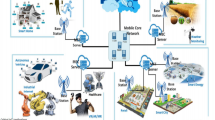Abstract
One of the biggest challenges in autonomous vehicles is processing massive data in real-time and task reliable decisions on time. In order to process data in real-time, the onboard unit is allocated with additional resources, which makes it more complex and consumes much power. To overcome this, an energy harvesting scheme (EH) along with offloading of tasks is proposed. The main motivation of autonomous vehicle is to avoid unnecessary accidents caused by negligence and human error. In this paper, allocation of the tasks between onboard unit and server unit utilizes the resources efficiently, and a novel task allocation scheme for allocating tasks between onboard unit and server unit is proposed. The decision of offloading, the processing unit frequencies and the corresponding power transmitted is computed using the proposed Harvest Energy Residue algorithm. This is a critical feature that enables reliable communication and produces a greater efficiency in IoT than the existing one. These decisions depend on direct data obtained, not on the distributed values of the channel, task details, and the EH process. The model is analyzed for EH and different allocation modes over the entire duration of the task. The results are simulated and shows that there is an improvement in the ratio of offloading computation tasks.











Similar content being viewed by others
References
Sheikh, M. S., Liang, J., Wang, W. (2020). "Security and Privacy in Vehicular Ad Hoc Network and Vehicle Cloud Computing: A Survey", Wireless Communications and Mobile Computing, 2020, 129620, pp. 25.
Chaudhry, S. A. (2021). "Designing an efficient and secure message exchange protocol for internet of vehicles", Security and Communication Networks, 2021, 5554318, pp. 9.
Yao, M., Wang, X., Gan, Q., Lin, Y., & Huang, C. (2021). An improved and privacy-preserving mutual authentication scheme with forward secrecy in VANETs. Security and Communication Networks. https://doi.org/10.1155/2021/6698099
Tassi, A., Mavromatis, I., Piechocki R. J., and Nix, A. (2019) "Secure data offloading strategy for connected and autonomous vehicles," 2019 IEEE 89th Vehicular Technology Conference (VTC2019-Spring), 2019, pp. 1–2.
Bayrak, A. E., et al. (2020). A system-of-systems approach to the strategic feasibility of modular vehicle fleets. IEEE Transactions on Systems, Man, and Cybernetics: Systems, 50(7), 2716–2728.
Jiang, X., Li, P., Li, B, Zou, Y., Wang, R. (2021) "Security-reliability tradeoff for friendly jammer aided multiuser scheduling in energy harvesting communications", Security and Communication Networks, 2021, 5599334, pp. 16.
The DARPA Urban Challenge. (2007). DARPA, Arlington, VA, USA.
Kumar, S., Gollakota, S., and Katabi, D. (2012). A cloud-assisted design forautonomous driving, In Proc. 1st Ed. MCC Workshop Mobile CloudComput. (MCC), 2012, pp. 41–46.
Sabella, D. et al. (2017). “Toward fully connected vehicles: Edge computing for advanced automotive communications,” 5GAA Autom. Assoc.,München, Germany, Rep.
Ahmed, E., & Rehmani, M. H. (2017). Mobile edge computing: Opportunities, solutions, and challenges. Future Generation Computer Systems, 70, 59–63.
Barbarossa, S., Sardellitti, S., & Lorenzo, P. D. (2014). Communicating while computing: Distributed mobile cloud computing over 5G heterogeneous networks. IEEE Single Processing Magazine, 31, 45–55.
Masoudi, M., Khamidehi, B., and Cavdar, C. (2017). “Green cloud computing for multi cell networks”, IEEE Wireless Communications and Networking Conference (WCNC), San Francisco, USA.
Sabitha, G., Manimegalai, C. T., Karthick Narayanan, S. R., et al. (2017). Reduction of complexity of on-board embedded robotic system processors using code offloading. Wireless Personal Communications, 97, 5089–5098.
Mao, Y. Y., Zhang, J., & Letaief, K. B. (2016). Dynamic computation offloading for mobile-edge computing with energy harvesting devices. IEEE Journal of Selected Areas Communications, 34, 3590–3605.
Wu, D., Huang, X., Xie, X., Nie, X., Bao, L., & Qin, Z. (2021). LEDGE: leveraging edge computing for resilient access management of mobile IoT. IEEE Transactions on Mobile Computing, 20(3), 1110–1125.
Ge, X. H., Tu, S., Mao, G. Q., Wang, C. X., & Han, T. (2016). 5G ultra-dense celluar networks. IEEE Wireless Communications, 23, 71–79.
Cao, Y., Li, D., Zhang, Y., & Chen, X. (2020). Joint optimization of delay-tolerant autonomous electric vehicles charge scheduling and station. IEEE Internet of Things Journal, 7(9), 8590–8599.
Keertikumar M., Shubham M., and Banakar, R. M. (2015) "Evolution of IoT in smart vehicles: An overview," 2015 International Conference on Green Computing and Internet of Things (ICGCIoT), pp. 804–809, https://doi.org/10.1109/ICGCIoT.2015.7380573.
Apollo. (2017). Autonomous Driving. [Online]. Available:http://apollo.auto/
Kwon, B., Park, J., & Lee, S. (2015). A target position decision algorithm based on analysis of path departure for an autonomous path keeping system”. Wireless Personal Communications. https://doi.org/10.1007/s11277-015-2485-0
Shalev-Shwartz, S., Shammah, S., and Shashua, A. (2016) “Safe, multi-agent, reinforcement learning for autonomous driving,” [Online].Available: arxiv.abs/1610.03295.
Lin, S. -C. et al. (2018). “The architectural implications of autonomous driving: Constraints and acceleration,” In Proc. ASPLOS, pp. 751–766.
Raiyn, J. (2020). “Performance metrics for positioning terminals based on a GNSS in autonomous vehicle networks” Wireless Pers Commun, pp. 114.
Ning, Z., Wang, X., Rodrigues, J. J. P. C., & Xia, F. (2019). Joint computation offloading, power allocation, and channel assignment for 5G-enabled traffic management systems. IEEE Transactions on Industrial Informatics, 15(5), 3058–3067.
Liu, J., & Zhang, Q. (2018). Offloading schemes in mobile edge computing for ultra-reliable low latency communications. IEEE Access, 6, 12825–12837.
Mao, Y., Zhang, J., & Letaief, K. B. (2016). Dynamic computation offloading for mobile-edge computing with energy harvesting devices. IEEE Journal on Selected Areas in Communications, 34(12), 3590–3605.
Sheng, J., Hu, J., Teng, X., Wang, B., & Pan, X. (2019). Computation offloading strategy in mobile edge computing. Information. https://doi.org/10.3390/info10060191
Funding
Not Applicable.
Author information
Authors and Affiliations
Corresponding author
Ethics declarations
Conflict of interest
The authors declare that they have no conflict of interest. The manuscript was written through contributions of all authors. All authors have given approval to the final version of the manuscript.
Additional information
Publisher's Note
Springer Nature remains neutral with regard to jurisdictional claims in published maps and institutional affiliations.
Rights and permissions
About this article
Cite this article
Bhanupriya, P., Gauni, S., Kalimuthu, K. et al. Knowledge Discovery of Edge Computation for Offload Vehicular Applications in IoT. Wireless Pers Commun 126, 2347–2359 (2022). https://doi.org/10.1007/s11277-021-09191-8
Accepted:
Published:
Issue Date:
DOI: https://doi.org/10.1007/s11277-021-09191-8




